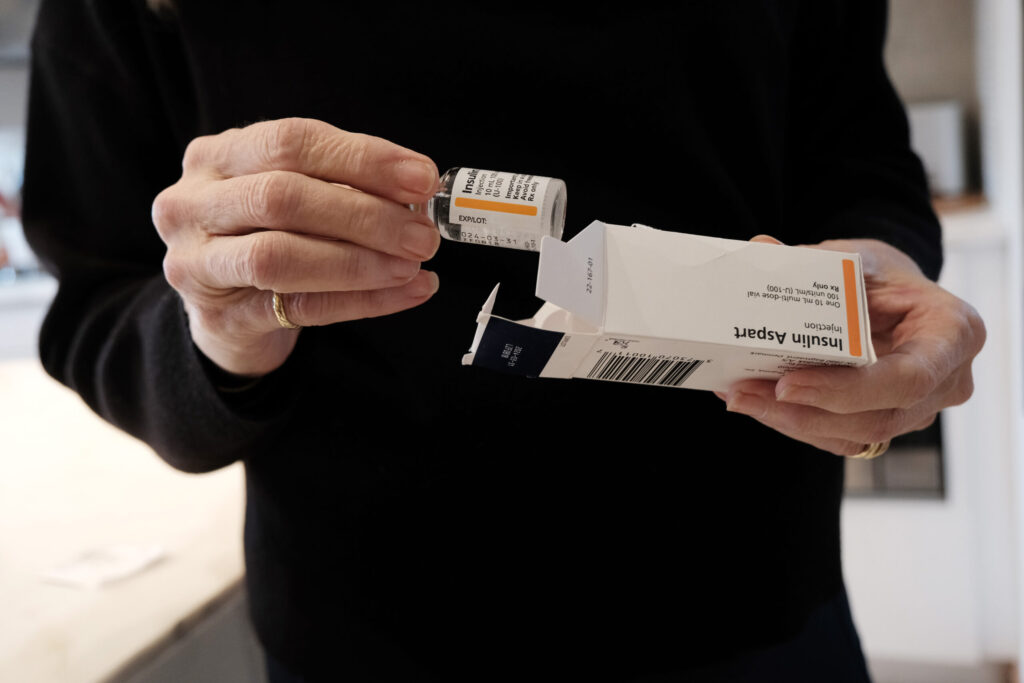In this photo illustration, Elizabeth Snouffer, whose had type 1 diabetes for most of her life, displays her insulin capsule which she needs to take daily on March 2, 2023, in New York City. Drugmaker Eli Lilly announced in March 2023 that it would cap the out-of-pocket cost of its insulin at $35 a month. Medical experts believe that the unexpected move may compel other insulin makers in the U.S. to follow suit and cap their prices of insulin. For those without health insurance or a health plan, the cost of insulin can cost hundreds or thousands of dollars a month for a diabetic. (Photo Illustration by Spencer Platt/Getty Images)
Writing political columns is what I do professionally (OK, it’s more like a hobby), but raising awareness about diabetes is at least a few notches higher on my “care” meter.
That’s because I have been battling the disease for more than 20 years and playing on “house money” throughout that time. I was on death’s doorstep 20 years ago, with a clogged heart slowly, but steadily, sucking the life out of me. A five-way bypass surgery took care of that problem and here I am today.
Working for free and enjoying every minute of it.
I belong to the Meridian Lions Club, which is a marvelous outlet for my passion. Globally, the Lions have been long recognized for its focus on eye and vision care and, in recent years, diabetes has moved toward the top of the priority list.
For good reason. Diabetes is a leading cause of blindness and the Lions figure, correctly, that stopping diabetes is a key to improving vision care.
The battle is never-ending. According to the American Diabetes Association, more than 37 million people have diabetes (it was just 25 million when I started making pitches more than a decade ago), and 95 million people have this ticking timebomb called pre-diabetes. So, that’s more than 100 million people in this country dealing with diabetes in some form.
Worldwide, the number jumps to nearly 540 million – with no signs of slowing down.
So, please forgive me for making a pitch for the Breakthrough T1D (formerly Juvenile Diabetes Research Foundation) walk, which will be held Oct. 12 at Kleiner Park in Meridian (9 a.m.). Around 400 people are expected to participate, and the fundraising goal is more than $63,300. That may not be huge numbers or big dollars, but it is one small step toward stopping this horrible disease.
The event may not have great relevance outside of the Treasure Valley, but the Breakthrough group is an important one – and especially for individuals and families dealing with type 1 diabetes. As the folks there put it, “no other does more to improve the everyday lives of people with type 1 diabetes – from therapy development and access, to expanding research advocacy and community support.”
Yes, they make the world a better place.
So, what does diabetes have to do with politics? More than you think. The insane cost of insulin is at the forefront of political discussions, with politicos battling to take credit for lowering the monthly cost of insulin. Republicans remind us that it was former President Donald Trump that got the ball rolling for some Medicare recipients, and Democrats want to make the $35 monthly cost available for everybody. And every year, Congress decides on increasing funding for continued research through the Centers for Disease Control and Prevention and National Institutes of Health. Idaho’s U.S. Sen. Jim Risch, for one, has long been singing praises for those agencies.
In this file photo, Idaho Secretary of State Phil McGrane talks with a supporter during the Idaho Republican Party primary celebration on May 17, 2022. (Otto Kitsinger for Idaho Capital Sun)
Here’s another connection – a political figure who is raising a child with type 1 diabetes. Idaho Secretary of State Phil McGrane, who is spending much of his time these days to ensure fairness in elections, knows all about the trials and tribulations. His 12-year-old daughter, Kennedy – known for her infectious smile and joyful personality – has type 1 diabetes.
“There are no days off, or breaks, from diabetes,” McGrane told me. “It was particularly hard at the onset and remains a challenge. My phone buzzes, and I get alerts when her (glucose) readings are high or low.”
The saving grace is that today’s technology has phone apps, insulin pumps and precise monitoring to keep parents and patients informed. Years ago, test strips and glucose meters were hard to find. There is no cure for diabetes, but the sophisticated monitoring systems are byproducts of research and development.
McGrane and his wife, Angella, have been through it all – from the parental nightmare that went with learning about their daughter’s diabetes diagnosis to doing everything under the sun to ensure a normal, and healthy life, for their daughter. And make no mistake, type 1 diabetes does not have to hold back their daughter from anything.
The McGrane family will be in good company when they line up for the start of the Breakthrough walk on Oct. 12. They will be with some 400 other people who are going through the same challenges.
GET THE MORNING HEADLINES.

